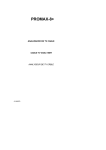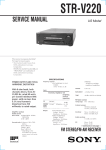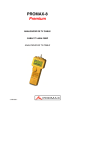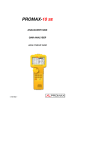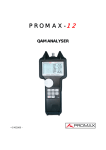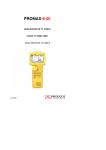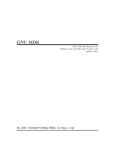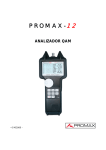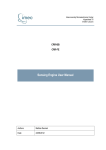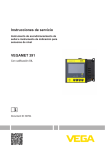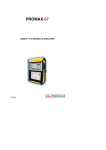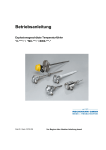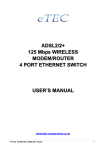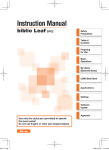Download E n g lish T A B L E O F C O N T E N T S
Transcript
USER’S MANUAL. PROMAX-10 Premium O F C O N T E N T S 1 GENERAL ...............................................................................................................1 1.1 Description ........................................................................................................1 1.2 Specifications....................................................................................................2 2 SAFETY RULES .....................................................................................................9 2.1 Generals ..........................................................................................................9 2.2 Descriptive Examples of Over-Voltage Categories ..........................................11 3 INSTALLATION.....................................................................................................13 3.1 Power supply ..................................................................................................13 3.1.1 Battery charge ..........................................................................................13 3.1.2 Recommendations for using the battery ....................................................14 3.2 Installation and start-up. ..................................................................................14 3.2.1 Contrast adjustment..................................................................................14 4 OPERATING INSTRUCTIONS..............................................................................15 4.1 Description of the controls and elements .........................................................15 4.2 Operating instructions .....................................................................................17 4.2.1 Global configuration menu ........................................................................19 4.2.2 SCAN operating mode ..............................................................................22 4.2.2.1 SCAN mode configuration...................................................................23 4.2.3 CHANNEL-FREQUENCY operating mode ................................................24 4.2.3.1 Channel tuning....................................................................................24 4.2.3.1.1 Video carrier + V/A + C/N measurement.......................................24 4.2.3.1.2 Audio carrier measurement and demodulation..............................25 4.2.3.1.3 CSO-CTB distortion products measurement .................................25 4.2.3.1.4 Power and C/N ratio measurement of digital channels (DVB-C / DVB-T / DAB). ..............................................................................27 4.2.3.1.5 Constellation Diagram representation, Bit Error Rate (BER) and Modulation Error Ratio (MER) measurement in digital channels. ..29 4.2.3.1.6 Configuration of QAM signal measurement using edit channel plan....29 4.2.3.2 Frequency tuning and configuration ....................................................30 4.2.3.3 CHANNEL-FREQUENCY mode configuration ....................................33 4.2.4 SPECTRUM ANALYSER operating mode. ...............................................34 4.2.4.1 SPECTRUM operating mode. .............................................................34 4.2.4.2 MAX operating mode. .........................................................................35 4.2.4.3 MIN operating mode. ..........................................................................36 4.2.4.4 TRANSIENT DETECTOR operating mode..........................................36 4.2.4.5 SPECTRUM ANALYSER mode configuration.....................................37 4.2.5 TILT operating mode.................................................................................38 4.2.5.1 TILT mode configuration. ....................................................................38 4.2.6 DATALOGGER operating mode................................................................39 4.2.6.1 Datalogger configuration. ....................................................................41 4.3 Connection to a Computer or Printer. ..............................................................42 English T A B L E USER’S MANUAL. PROMAX-10 Premium CABLE TV ANALYSER PROMAX-10 Premium 1 GENERAL 1.1 Description The PROMAX-10 Premium is seven functions in one instrument, Level Meter, Datalogger, Scan, Tilt, Spectrum Analyser, Transient Detector, and Cable Digital Analyser which makes it an excellent tool for the installation and maintenance of analogue and digital television signal reception/distribution systems working in the 5 to 862 MHz range, which includes FM radio, community TV systems (MATV), cable TV (CATV) and wireless cable TV (MMDS) including the sub-band (return path). As a Level Meter, the PROMAX-10 Premium enables the following measurements: Analogue channels: - Video carrier level measurement - Carrier / Noise ratio measurement (C/N) - Video / Audio ratio measurement (V/A) - CSO and CTB Intermodulation distortion measurement Digital channels DVB-C, DVB-T and DAB: - Channel power measurement by integration - Carrier / Noise ratio measurement (C/N) - Bit Error Rate (BER) measurement - Modulation Error Ratio (MER) measurement - Graphical representation of DVB-QAM signals Constellation Diagram. The Datalogger function allows up to 55 loggers or measurements to be taken and stored, each with carrier levels, C/N and V/A ratios, channel power or MER of up to 140 channels. The measurements obtained may be checked, transferred to a PC or printed at any time. In Scan operating mode, the PROMAX-10 Premium indicates the level of all channels present on the band in a bar-graph display. The span and reference level are user definable. A moving marker shows the exact level of each specific channel. In Tilt operating mode, the screen shows, both graphically and numerically, the difference in levels between any four previously defined pilot frequency channels, in order to obtain a qualitative measurement on band equalisation. 05/2004 Page 1 English The PROMAX-10 Premium incorporates the power level measurement function in the whole frequency band, very useful to check a possible input saturation of some broadband demodulators. USER’S MANUAL. PROMAX-10 Premium As a Spectrum Analyser it provides the analysis of the entire band, with a span defined by the user from 1 to 100 MHz. Furthermore, it is possible to alter the reference level, and to detect and maintain the maximum and minimum values for INGRESS measurements. The Transient Detector mode, permits to count the number of impulsive interferences in the return path and with a level higher than a threshold defined by the user. The maximum frequency range is from 5 to 100 MHz. In designing the PROMAX-10 Premium, special attention was given to building a multi-purpose, accurate, yet easy-to-use instrument. A simple keyboard gives direct access to the various operating modes and, once in them, any measurement parameter can be easily changed using the rotary selector/button. In addition, it has an RS-232C terminal for connecting to a printer or computer for producing reports on the measurements obtained. The instrument is powered by means of an internal rechargeable battery. All these functions have been brought together in one instrument weighing only half a kilo. The ergonomic, sturdy design makes the PROMAX-10 Premium a working tool without parallel. 1.2 Specifications TUNING Tuning range Tuning mode Channel plan Resolution Indication Channel frequency offset From 5 to 862 MHz. By channels or by frequency. 10 channel plans, each one with a maximum of 140 channels. Factory start-up channel plans: CCIR, EIA, OIRL, JAP2, UK, FCC, STD2L, AUST (1). 10 kHz. Graphic LCD with back lighting. ± 2 MHz (10 kHz resolution). POWER LEVEL MEASUREMENT Measuring range Bandwidth Resolution Accuracy From 70 to 120 dBµV (From 10 dBmV to 60 dBmV (2)). From 5 to 862 MHz 1 dB ± 3 dB (From 5 to 40 °C) LEVEL MEASUREMENT Measurement Analogue channels Digital channels Measuring range Page 2 Video carrier level measurement. Power measurement in the channel bandwidth by integration method. From 25 to 120 dBµV. (From -35 dBmV to 60 dBmV)(2). 05/2004 USER’S MANUAL. PROMAX-10 Premium DIGITAL SIGNALS MEASUREMENT MER (Modulation error ratio) 22 dB to 34 dB for 64 QAM. Measurement range Accuracy ± 2 dB BER (Bit error rate) Measured before RS decoding 10 E-2 to 10 E-8 Measurement range DVB-QAM signals (Annex A/B/C) and DOCSIS / Constellation Diagram Euro-DOCSIS -10 dBmV to 60 dBmV Lock range Symbol rate 1000 to 7200 Msym/s* for 16/64/256 QAM Measurement range For each digital channel, the level and the MER can Datalogger be stored. (BER for data dumping to printer or transfer to PC) 16/32/64/128/256 QAM ITU J1 annex A/C and Modulation type 64/256 QAM ITU J1 annex B. 8 MHz Bandwidth 62.5 kHz. Frequency tuner VIDEO / AUDIO RATIO MEASUREMENT (ANALOGUE CHANNELS) Ratio of video to audio carrier levels. Measurement From 0 to 40 dB Measurement range Audio subcarrier frequency 4-9 MHz. Variable ± 2 dB (from 5 to 40 °C) for FM audio carrier (4). Accuracy * Including the OP-010-E option, otherwise the margin is from 1000 to 7000. English Maximum input level 120 dBµV. (60 dBmV (2)). From 5 to 862 MHz 60 V DC or RMS DC to 60 Hz Reduction of the measurement range depending on the number of channels. 110 dBµV. Up to 10 channels 107 dBµV. From 11 to 20 channels 103 dBµV. From 21 to 50 channels 101 dBµV. From 51 to 80 channels Digital in dBµV, dBmV or dBm and analogue Readout through a graphic bar. 1 dB resolution 230 kHz ± 50kHz IF bandwidth 75 Ω Input impedance Tone which varies with the signal level. Audible indicator Accuracy Analogue channels ± 2 dB (from 0 to 40 °C) for negative video modulation (3). Digital channels ± 3 dB (from 0 to 40 °C) for 8 MHz bandwidth channels. USER’S MANUAL. PROMAX-10 Premium CARRIER / NOISE RATIO MEASUREMENT Measurement Ratio between carrier level and the channel's noise Analogue channels level. Ratio between the channel power and the noise Digital channels level. The frequency where noise is measured is user definable in absolute or relative value. In the relative mode, the unit takes as default frequency offset the value BW/2 + 0.5 MHz. Measurement range (5) 40-50 dB for input level between 60 and 70 dBµV. Analogue channels > 50 dB for input level > 70 dBµV. > 30 dB for input level > 60 dBµV. Digital channels Accuracy ± 2 dB (45 – 862 MHz) ± 3 dB (5 – 45 MHz) CSO & CTB INTERMODULATION PRODUCTS MEASUREMENT (ANALOGUE CHANNELS) Ratio of the peak level of the video carrier to the CSO peak of the distortion products of second order beat. Measured at four frequencies user definable. User definable from -2.50 to -0.50 MHz and from Measuring frequencies 0.50 to 2.50 MHz. (Default values -1.50, -0.50, 0.50 and 1.50 MHz). Ratio of the peak level of the video carrier to the CTB peak of the distortion products of third order beat. Measured at the carrier frequency or, approximately mode, in a channel previously defined by the user. DATALOGGER FUNCTION Max. number of loggers Number of channels/logger Measurements Analogue channels Digital channels SCAN Span Power detection Reference level TILT Indication Analysed band Number of pilots Pilots frequency Pilots resolution Page 4 55 140 Level, C/N and V/A. Channel power and MER. (BER for data dumping to printer or transfer to PC). Variable: 10, 30, 100, 300 MHz and full band (from 5 to 862 MHz, according to the channel plan). Forward band (45 to 862 MHz). Variable from 60 to 120 dBµV in 10 dB steps. Numerical and by level bar. Forward (45 to 862 MHz) or Return path (5 to 100 MHz). 4 per band. From 5 to 862 MHz. 10 kHz. 05/2004 USER’S MANUAL. PROMAX-10 Premium Detector Bandwidth Resolution Peak detector Span 100 MHz Span 50 MHz Span 30 MHz Span 15 MHz Span 5 MHz Span 1 MHz Average detector Span 30 MHz Span 15 MHz Span 5 MHz Span 1 MHz TRANSIENT DETECTOR Detection threshold Detection range Readout AUDIO Demodulation From 1 to 100 MHz (1, 5, 15, 30, 50, 100 MHz). Variable from 60 to 120 dBµV in 10 dB steps. Forward (45 to 862 MHz) or Return path (5 to 100 MHz). Peak or average. 230 kHz. 900 kHz. 450 kHz. 280 kHz. 140 kHz. 50 kHz. 10 kHz. 280 kHz. 140 kHz. 50 kHz. 10 kHz. From 20 to 60 dBµV in steps of 1 dB. From 5 to 100 MHz maximum. Number of detected transitory in the measuring time. Present detected level and maximum detected level in the time of the measurement. Output AM / FM / LEVEL (variable tone according to the signal level). Internal speaker / external headphones. POWER SUPPLY LNB Input Output Voltage Current Protection By external power supply. By input signal connector. 24 V nominal (25 V max.). 500 mA max. Current limiter. POWER SUPPLY NiMh battery 7.2 V – 1.4 Ah. Low battery indication Autonomy Automatic power-off Battery charge Equipment consumption Graphic indication on the display: Approximately 3 hours (30 % on / off excepting measurements of MER / BER). Power-off after approximately 10 minutes of non-use. By fast internal charger. 13.5 W. English SPECTRUM ANALYSER Span Reference level Analysed band USER’S MANUAL. PROMAX-10 Premium Mains to charger adapter 230 V / 50-60 Hz / 13.5 V DC minimum (EUROPE and other countries). ENVIRONMENTAL CONDITIONS This equipment could be used on the following environmental conditions, in these conditions the specifications could also be applied: Altitude Temperature range Maximum relative humidity MECHANICAL FEATURES Dimensions Weight (1) (2) (3) (4) (5) Up to 2000 metres. From 5 °C to 40 °C. 80 % (up to 31 °C), decreasing lineally up to 50% at 40ºC. 70 W (90 on the display) x 218 H x 50 D mm. 825 g. (including battery and holster). Under request carried out at the factory. (See option OP-010-61) Because of safety reasons, the maximum input power over the entire band limited up to 120 dBµV. The equivalent power level for a group of channels similar levels is related with the input power level over the entire band according the following expression: LT = L+10 log N (LT: total level , L: mean level of one channel, N: number is of to of channels present). For higher input power levels, the use of an external attenuator of 20 dB is recommended. There may be certain frequencies where the symbol "<" appears at levels higher than 25 dBµV (maximum 28 dB). This is due to the automatic correction of the frequency response. The value measured remains correct, although the accuracy becomes ±3 dB For the positive video modulation (L standard) it can vary from 0 to -2 dB among white and black image. For the AM audio carrier (L standard), it can vary from 0 to -3 dB below the V/A value. See appendix E INCLUDED ACCESSORIES AL-012 EUROPE and other countries 230 V / 50-60 Hz mains adapter (basic version only). AL-022 USA and CANADA 120 V / 50-60 Hz mains adapter (only with the OPT-010-1). AL-032 UK 230 V / 50-60 Hz mains adapter (only with the OP-010-2). AL-042 Australia 240 V/50-60 Hz mains adapter (only with the OP-010-3) AL-052 Japan 100 V / 50-60 Hz mains adapter (only with the OP-010-4). AA-012 Car cigarette lighter adapter cable. DC-239 PROMAX-10 Premium Carrying case. DC-286 Carrier belt. AD-057 F/female - F/female input adapter. AD-058 F/male - F/female rapid adapter. CC-030 F/male - F/male (1m) coaxial cable. DC-284 Rubber holster. Page 6 05/2004 USER’S MANUAL. PROMAX-10 Premium OPTIONS OP-010-1 OP-010-2 OP-010-3 OP-010-4 OP-010-61 OP-010-E Substitute mains adapter by AL-022. Substitute mains adapter by AL-032. Substitute mains adapter by AL-042. Substitute mains adapter by AL-052. Change channel plan. (Carried out under request in the factory). Extension of SYMBOL RATE measurement range. English OPTIONAL ACCESSORIES AD-055 F/female - BNC/female adapter. AD-056 F/female - IEC/female adapter. CI-023 Portable serial printer. CC-208 Data transfer cable to PC or printer. RM-010 Remote control software for PROMAX-10 Premium. AT-20C 20 dB attenuator. USER’S MANUAL. PROMAX-10 Premium 2 SAFETY RULES 2.1 Generals * Use this equipment connected only to devices or systems with their common at ground potential. * This equipment can be used in Over-Voltage Category I installations and Pollution Degree 2 environments. Use the mains adapter in Over-Voltage Category II installations and Pollution Degree 1 environments. It is for INDOOR USE. * When using some of the following accessories use only the specified ones to ensure safety. * Observe all specified ratings both of supply and measurement. * Use this instrument under the specified environmental conditions. * The user is not authorised to manipulate inside the instrument: Any other change on the equipment should be carried out by qualified personnel. On the Maintenance paragraph the proper instructions are given. * Follow the cleaning instructions described in the Maintenance paragraph. English Power adapter Car cigarette lighter adapter USER’S MANUAL. PROMAX-10 Premium * Symbols related with safety: DIRECT CURRENT ALTERNATING CURRENT DIRECT AND ALTERNATING GROUND TERMINAL PROTECTIVE CONDUCTOR FRAME TERMINAL EQUIPOTENTIALITY ON (Supply) OFF (Supply) DOUBLE INSULATION (Class II protection) CAUTION (Risk of electric shock) CAUTION REFER TO MANUAL FUSE Page 10 05/2004 USER’S MANUAL. PROMAX-10 Premium Descriptive Examples of Over-Voltage Categories Cat. I Low voltage installations isolated from the mains. Cat. II Portable domestic installations. Cat. III Fixed domestic installations. Cat. IV Industrial installations. English 2.2 USER’S MANUAL. PROMAX-10 Premium 3 INSTALLATION 3.1 Power supply The PROMAX-10 Premium is a portable instrument powered by a built-in 7.2 V NiMh rechargable battery. Before taking any measurement, the user should make sure that the battery is fully charged (use the mains adapter supplied with the instrument). 3.1.1 Battery charge The instrument has a 230 V / 50-60 Hz, mains adapter, for use in EUROPE and other countries, to power or to charge the instrument. (See accessories to request other types of adapters). 1) With the instrument stopped, on having connected the external power adapter, begins a cycle of fast load which duration will depend on the battery state. For an empty battery this time will be of 2.5 h. approximately. The charge indicator of frontal panel will remain illuminated during this period. On having finished the battery charge the indicator will be illuminated blinking to indicate that a maintenance charge takes place. 2) With the instrument working, when connecting the power adapter, this one feeds the instrument and provides a maintenance charge, remaining illuminated the charge indicator. The MER / BER measurements produce a light discharge of the battery in spite of the external power adapter being connected. ATTENTION When stopping the instrument is reinitiated a charge process. It is for that reason recommendable to discharge the battery using instrument without external power adapter to make complete the charge / discharge process. ATTENTION The charge system of PROMAX-10 Premium incorporates a security system that does not allow the process charge from certain temperature limit, begining the maintenance charge instead. CAUTION Before using the power adapter, make sure that the adapter is suitable for the mains voltage. Figure 1.- PROMAX-10 Premium and mains adapter connection. English There are two different situations on battery charge: USER’S MANUAL. PROMAX-10 Premium 3.1.2 Recommendations for using the battery In case of anticipating a long period of inactivity for the equipment it is recommended to store it with the battery discharged. When the equipment starts the operation after a long period of inactivity to follow next steps: • Put to charge the instrument with the external adapter. • If it starts on the maintenance mode (indicator flashing) wait for the pass to the charging mode (indicator lighting permanently). • Start up the equipment, assuring that the function AUTO POWER OFF is OFF, the indicator will stand permanently lighted and it will stay in this condition during a period of time about 10 to 14 hours. Use the equipment in normal way, reason why after one to three whole cycles of charge/discharge, depending on the time and temperature of inactivity, the battery will have been reconditioned. 3.2 Installation and start-up. The PROMAX-10 Premium has been designed for use as portable equipment. A fully charged battery can power the equipment for more than three hours. When the low battery indicator appears on the display ( recharged. ), the battery must be When a fully discharged battery is installed, it is possible that, due to residual charges, the PROMAX-10 Premium may start up. In this case, the instrument will automatically disconnect before the low battery indicator appears on the display. 3.2.1 Contrast adjustment When turning on the PROMAX-10 Premium, if the on/off key [16] is held pushed, on the display will appear the message 'CONTRAST ADJUSTMENT - Turn the rotary selector', then turning the rotary selector [9] it is possible to adjust the display contrast to get the best viewing according to working conditions. The new contrast value is held when the unit is turned off and when battery is removed. Page 14 05/2004 USER’S MANUAL. PROMAX-10 Premium 4 OPERATING INSTRUCTIONS 4.1 Description of the controls and elements English Front panel Figure 2.- Front panel. [1] F-F (or F-BNC or F-IEC) adapter. Maximum input voltage level 60 VAC rms /50-60 Hz. [2] "F" male base connector. [3] Graphic display with back lighting. [4] DC power adapter external input. [5] Volume control. [6] Keyboard. 7 keys for function selection. USER’S MANUAL. PROMAX-10 Premium [7] Loudspeaker. [8] Connection to computer or printer. CC-208 specific connection cable. Do not connect any cable other than that supplied by the manufacturer, otherwise the instrument may suffer serious damage. [9] Rotary selector / Push button. Figure 3.- PROMAX-10 Premium keyboard. [10] Selects the CHANNEL - FREQUENCY operating mode. [11] Selects the SCAN operating mode. [12] Selects the TILT operating mode. [13] Selects the SPECTRUM ANALYSER and the TRANSIENT DETECTOR operating modes. Page 16 05/2004 USER’S MANUAL. PROMAX-10 Premium [14] Access to CONFIGURATION menus specific to each operating mode and to the global configuration menu of the unit. [15] Selects the DATALOGGER operating mode. Enables multiple measurements to be taken, visualised, printed or transferred to a PC automatically. [16] On/Off key. [17] LNB exterrnal supply indicator. [18] Battery charge indicator. Operating instructions The PROMAX-10 Premium has 6 independent operating modes: The CHANNEL-FREQUENCY operating mode measures the video carrier level, the Carrier/Noise ratio (C/N), the Video/Audio ratio (V/A) and activates audio carrier demodulation for analogue channels; as well as measuring the channel power and the Carrier/Noise ratio (C/N), the Bit Error rate (BER) and the Modulation Error ratio (MER) and represent the Constellation Diagram for digital channels. It also permits to measure the CSO and CTB intermodulation distortion. The DATALOGGER operating mode enables multiple measurements to be performed and memorised for subsequent checking, transfer to PC or printing. It can perform and store up to 55 obtained measurements or loggers in the memory. Each logger carries out level, C/N, V/A, channel power or MER measurements on the channels activated in the channel plan (up to a maximum of 140 channels). The SCAN operating mode shows the signal level of all channels present on the chosen frequency band in a bar-graph display. The span and the reference level may be selected through the rotary selector. In addition, a moving marker shows the numeric level of any specific channel. This mode also permits to define the pilot channels, used for the TILT measurement (only in the forward band). This key permits to accede to 2 operating modes: The SPECTRUM ANALYSER mode provides a spectrum analysis over the entire band in two parts: return path or sub-band (5 to 100 MHz) and forward band (5 to 862 MHz). The span is user definable between 1 and 100 MHz. In addition, it is possible to change the reference level, and maximum and minimum levels may be detected and held for INGRESS measurements. English 4.2 USER’S MANUAL. PROMAX-10 Premium In the TRANSIENT DETECTOR mode, the PROMAX-10 Premium operates as a transitory counter in the return path. The level detection threshold and the frequency margin are user definable. The TILT operating mode shows on the display, both graphically and numerically, the level difference between any four channels, previously defined as pilot channels, in order to obtain information about band equalisation. This function can be applied to the forward band and to the return path, independently. To access any operating mode, simply press the corresponding key. The parameters relative to a particular operating mode can be modified through the configuration menu associated to the mode. In order to accede to the configuration menu associated to a particular operating mode, simply press the CONFIG key [14]. Some modes have more than one configuration page, to accede to the second page it is necessary to press the CONFIG key again. The general parameters of configuration (selecting/editing the channel plan, measurement units, language, etc.) can be changed through the Global Configuration Menu, to which it is acceded by pressing again the CONFIG key [14]. To leave a configuration menu, just press the key of the operating mode you wish to accede. Figure 4.- PROMAX-10 Premium configuration menus. Page 18 05/2004 USER’S MANUAL. PROMAX-10 Premium 4.2.1 Global configuration menu In order to accede to the global configuration menu, from any operating mode (SCAN, CH-FR, SPECT, etc.), you must press the CONFIG [14] key repeatedly (the first time that presses this key accedes to the configuration menu relative to the mode in use, which can have more than one page). The global configuration menu Figure 5.- Global configuration. 1/2. consists of two pages (attached figure shows the first one), to switch from one to the other simply press the CONFIG [14] key. In order to modify the state of a given parameter, you must turn the rotary selector [9] until this one appears shaded and next press it, then the value of the parameter will appear shaded and turning the selector a new value will be able to be defined. Finally, to validate the new state, press the rotary selector [9] again. a) CHANNEL PLAN It allows you to choose the active channel plan between the 10 channel plans that unit can store (CCIR, EIA, FCC, etc.). b) EDIT CHANNEL PLAN. When selecting this field and pressing the rotary selector, the unit accedes to the active CHANNEL PLAN. The attached figure shows an example of channel plan. The first line shows the name of the channel plan (CCIR in the figure), the audio carrier offset (5.50 MHz), the modulation type (FM) and the units of measurement (dBµV). Next line shows the head of the columns that constitute the channel plan: the first column (CHAN) shows the name of each Figura 6.- Editing a channel plan. channel and the second one (FREQ) the associated frequency, in MHz. The third column (BW) defines channel bandwidth, in MHz. The fourth column (ON) activates or deactivates the channel and the fifth ones (DIG) defines if the channel is analogue or digital. In the case of defining the channel as digital, the configuration page of parameters relative to QAM measurement will be accessed directly (see section 4.2.3.1.6). The maximum number of channels in a channel plan is of 140. The activation (ON) / deactivation (OFF) of the channels affects to the following operation modes: CH-FR, SCAN and DATALOGGER. When a channel has been deactivated, this one will not be able to be tuned nor to be measured. This property allows to make agile the operation of the PROMAX-10 Premium, because it allows to activate only those channels in which we are interested. English The first page of the global configuration menu permits to modify the following parameters: USER’S MANUAL. PROMAX-10 Premium The Edit Channel Plan function allows to automatically activate all the channels defined in the channel plan by means of the ALL field on the third line. When to the right of ALL we select ON, all the channels of the plan will be activated, otherwise, if we select OFF all channels will be deactivated. In order to activate / deactivate a particular channel, turn the rotary selector [9] until this one appears shaded and then press it, the cursor will jump to the ON column, then turning the selector it will be possible to activate it (it appears a cross) or to deactivate it (it does not appear a cross). By means of the Edit Channel Plan function also it is possible to define channels as analogue or digital. To do this, turn the rotary selector [9] until the channel that you wish to modify appears shaded and then press it twice, the cursor will jump to the DIG column, then turning the selector it will be possible to define it as digital (appears a cross, channel C04 in the example of the previous figure) or as analogue (it does not appear a cross). In the case of selecting it as digital it is possible to accede directly to the digital channel configuration. In order to return to the Edit Channel Plan function press the CONFIG [14] key. To modify the rest of characteristics of the channel plans it is necessary to have the RM-010 software (optional accessory). c) UNITS The PROMAX-10 Premium permits to select the level units between dBmV, dBµV and dBm. d) TIME To enter the time select the TIME field and press the rotary selector. Firstly, turn the rotary selector to change the minutes field. Next press the selector again to modify the hours and finally press it once again to confirm the new time. e) DATE To enter the date select the DATE field and press the rotary selector. First change the year field, then the month and finally the day. The parameters which may be modified on the second page of the global configuration menu of the unit are as follows: Figure 7.- Global configuration. 2/2. f) AUTO POWER OFF This field permits to activate (ON) or deactivate (OFF) the POWER-OFF function. When this function is ON, the unit automatically turns off when it has remained inactive for a period of 10 minutes. g) BEEP This function permits to activate (ON) or deactivate (OFF) the PROMAX-10 Premium beeper. When it is on, it sounds on pressing any key or when turning the rotary selector in order to alert the user. Page 20 05/2004 USER’S MANUAL. PROMAX-10 Premium h) LANGUAGE This field permits to select the language between: ESPANOL, FRANÇAIS, ENGLISH and DEUTSCH. i) EXTERNAL UNITS POWER SUPPLY (VLNB) By means of the PROMAX-10 Premium it is possible to provide the voltage necessary to feed external units (MMDS antennas Multichannel Multipoint Distribution Service in case of terrestrial television without cable wireless cable) by the signal input connector. This voltage will have to be provided externally by the power input [4] and to be included in the margin from 21 to 25 V, in opposite case the instrument will not allow to activate this function, displaying the message "Error VEXT " at the moment of the configuration. - Press repeatedly the key CONFIG until acceding to the second screen of the configuration menu. - Turn the rotary selector until appears shaded line VLNB. - Press the rotary selector to activate the selection. Turning the rotary selector, this one goes successively of OFF to ON. - Finally, to press the rotary selector to activate the configuration changes. When surpassing the maximum LNB current consumption the output feeding will be deactivated and LED (VLNB) from frontal will blink during a minute. In order to reactivate again the LNB voltage, after solving the cause of malfuction, it must be access again to the instrument configuration according to the sequence previously described. ATTENTION Before using the LNB feeding function make sure of absence of other power supplies in the measurement/power supply connector like DC / AC voltages. The entrance of external voltages when trying to feed from the PROMAX-10 Premium, can produce damages in the implied equipment. IMPORTANT To leave the global configuration menu, just press the key of the operating mode you wish to accede. The lower line of the screen shows the version of the unit control software (2.32 in previous figure). English The activation or deactivation of VLNB takes place according to the described process next: USER’S MANUAL. PROMAX-10 Premium 4.2.2 SCAN operating mode The SCAN operating mode shows, in a single screen, the signal level of all the active channels in the channel plan by means of a bar-graph. In addition, the exact level of any particular channel may be measured by simply placing the marker over it (only analogue channels). To access to this operating mode, press the SCAN key [11]. The top line of the screen will display the channel name (C44), the tuned frequency (655.25 MHz) and the level (65 dBµV) of the channel the marker is over. The marker can be moved by turning the rotary selector [9]. Figure 8.- SCAN mode, full span. The channel is selected when it is shaded. To change the span (shown bandwidth), press the rotary selector [9] (the span field is activated) and then turn it. The span is variable from the entire band (full span) to 10 MHz in the following steps: 10, 30, 100, 300 MHz y full span. Figure 9.- SCAN mode, span 100 MHz. By pressing the rotary selector [9] again, you can change the reference level, in other words, on turning the rotary selecter [9] the graph is displaced vertically. To modify the tuned channel, press the rotary selector [9] again, the channel field will be activited and then turning the rotary selector you will be able to change it. Figure 10.- SCAN mode, Ref. 90 dBµV. The attached figure shows an horizontal line at 45 dBµV. This line allows to establish judgements of channel level acceptance easily. To activate and define this reference line see the Scan configuration menu (section 4.2.2.1). Figure 11.- SCAN mode with reference line at 45 dBµV. Page 22 05/2004 USER’S MANUAL. PROMAX-10 Premium In the case of having activated the broadband power detection function (POWER MEAS -> ∑PWR) in the configuration menu of SCAN mode (See section 4.2.2.1), on the display of PROMAX-10 Premium will appear the total power level on the instrument RF input. See the attached figure. Figure 12.- SCAN mode, power detection function. This parameter indicates the total power that is being transmitted by the connected coaxial cable to the PROMAX-10 Premium in the band from 5 to 862 MHz. The SCAN operating mode also allows channels to be programmed for use as pilots in TILT operating mode, in the forward band (see section 4.2.5 TILT operating mode). IMPORTANT 4.2.2.1 SCAN mode configuration In the SCAN operating mode, pressing the CONFIG key [14] will access the configuration menu for this mode. This menu permits to change three parameters: THRESHOLD, REFERENCE LINE and POWER Figure 13.- SCAN configuration menu. MEASUREMENT. To accede to any of them, turn the rotary selector [9] until it appears shaded and next press the selector, then the value of the parameter will appear shaded and turning the selector you will be able to modify its value. Finally, to validate the new value, press the rotary selector [9] again. a) THRESHOLD It defines the minimum level to show channel on the display (OFF or between 21 and 120 dBµV). If the threshold is deactivated (OFF), on the SCAN representation will appear all the active channels of the channel plan with a level higher than 20 dBµV. Otherwise, if we define a level for the THRESHOLD parameter, channels with a level lower than the threshold value will not be displayed. b) REFERENCE LINE It permits to activate or to deactivate (OFF) a reference line on the SCAN graph (between 21 and 120 dBµV). This reference line allows to establish judgements of channel level acceptance just with a glance at the SCAN screen. c) POWER MEASUREMENT It allows to define if the measurement of the power is carried out on the channel bandwidth (CHAN) indicates by the MARKER or over the full band between 5 and 862 MHz (∑PWR). English In the SCAN operating mode, all channels are considered as analogue, as a consequence digital channels power must be measured always from the CHANNEL-FREQUENCY operating mode. USER’S MANUAL. PROMAX-10 Premium IMPORTANT To leave the SCAN operating mode configuration menu, just press the key of the operating mode you wish to access. 4.2.3 CHANNEL-FREQUENCY operating mode The CHANNEL-FREQUENCY measurements: operating mode provides the following Analogue channels: - Video carrier level - Carrier / Noise (C/N) ratio - Video / Audio (V/A) ratio - CSO-CTB intermodulation distortion measurement Digital channels: - Channel power by measurements integration - Carrier / Noise (C/N) ratio - Bit error rate (BER) - Modulation error ratio (MER) - Constellation Diagram To access to this mode of operation, press the CH-FR key [10]. There exist two tuning modes: by channel or by frequency. When pressing the CH-FR key [10], if the instrument is in this mode allows the switching from channel tuning to frequency tuning. 4.2.3.1 4.2.3.1.1 Channel tuning Video carrier + V/A + C/N measurement If the tuned channel has been defined as analogue by means of the Edit Channel Plan function (see section 4.2.1 Global Configuration Menu), the PROMAX-10 Premium will display a screen as the one shown in the attached figure. The tuned channel (C69 in the figure) Figure 14.- V/A and C/N Level appears in the higher left hand corner; this may be measurement changed by turning the rotary selector [9]. At its right appears the frequency (855.25 MHz) and the active channel plan (CCIR in the figure). Below is shown the video carrier level, VIDEO Carrier (80 dBµV in the example). The units of measurement may be changed using the Global Configuration Menu (section 4.2.1). At the bottom, a bar-graph displays the level with a resolution of 1 dB. Also the ratios between the video and the audio carriers (V/A) and the video carrier and noise (C/N) are shown. The example in previous figure shows a channel with a Video/Audio ratio of 16 dB and a C/N ratio of 54 dB. USER’S MANUAL. PROMAX-10 Premium 4.2.3.1.2 Audio carrier measurement and demodulation For the PROMAX-10 Premium to demodulate an audio signal and show its characteristics (level and frequency offset), press the rotary selector [9] again. In the attached figure, the audio carrier level (AUDIO Carrier) is 64 dBµV and the frequency offset is 5.50 MHz ( F). It also shows if the audio (whether Level, Figure 15.- Audio demodulation FM or AM) is activated (a speaker appears) or not (no and measurement. icon appears). To change the audio carrier offset ( F) and the audio modulation (Level, FM or AM) accede to the Channel-Frequency configuration menu (section 4.2.3.3). 4.2.3.1.3 CSO-CTB distortion products measurement The distortion products of greater level and which usually fall within the channel bandwidth are those of second and third order beats. The CSO distortion (Composite Second Order) is defined, as a ratio of the peak level of the video carrier to the peak of the distortion products of second order beat, produced by the rest of channels. The ratio is expressed in dB and can be resembled to a C/N measurement as it is desired to be maximum. Similarly, the CTB, Composite Triple Beat, is defined as a ratio of the peak level of the video carrier to the peak of distortion products of third order beat, which show up at the same frequency as the video carrier. In order to obtain these measurements, the carriers of the channel plan that is desired to transmit, must be present in the network and the measurements must be carried out for each one of the channels of the system. Second order beats show up within the channel, around the video carrier, but as the relative position of the video carrier in all the channels can be different, it is difficult to determine where they are going to appear, as a consequence we would have to be made a sweep within all the channel. The PROMAX-10 Premium performs this measurement automatically at four frequencies around the video carrier (-1.5, -0.5, +0.5 and +1.5 MHz). These frequencies can be modified by the user, see ChannelFrequency mode configuration menu (section 4.2.3.3). English The active devices present in the distribution systems, when working in its nonlinear zone, generate interferent signals, called distortion products, that can fall within the video bandwidth. From a certain level this interference becomes visible on the TV image. USER’S MANUAL. PROMAX-10 Premium Figure 16.- Interpretation of the CSO and CTB measures. The PROMAX-10 Premium displays as CSO value the worst measurement (that is to say, the CSO ratio that has minor value) accompanied of the frequency offset for which it has been obtained (for example, in the figure previous at +0.5 MHz). The CTB measurement is performed equivalently to the CSO. If all the channels that are transmitted have the video carrier at the same position within the channel, then the CTB beat will show up at the same frequency as the video carrier. It is for that reason, that the PROMAX-10 Premium makes this measurement at the same frequency as the video carrier and, as consequence, to make this measurement it is necessary to turn off the video carrier of the channel we want to analyse. If it is not possible to turn off the carrier at the head-end, the PROMAX-10 Premium allows, like approach, to make this measurement at one of the free adjacent channels (see section 4.2.3.3. Channel-Frequency mode configuration). MEASURING METHOD When pressing the rotary selector [9] again, we will accede to the CSO-CTB distortion products measuring screen. First of all it will appear the message REMOVE CARRIER. PRESS TO MEASURE. That is to say, once the video carrier level on which it is desired to make the measurement appears on the screen, Figure 17.- CSO and CTB you must press the rotary selector [9] in order that measurement. the unit retains the carrier level and comes to calculate the CSO and CTB ratios; next you must turn off the video carrier of the channel you want to make the measurement (at the right of the CTB measurement will appear the message Carrier OFF). The display will show the level of the video carrier (80 dBµV in the previous figure) and the CSO ratio (accompanied by the frequency offset for which the minimum ratio has been obtained) and the CTB ratio (with the message Carrier OFF or Carrier ON according to the equipment has detected the absence or not of carrier). The lower part of the screen shows the 4 measures made for the estimation of the CSO value. USER’S MANUAL. PROMAX-10 Premium If the rotary selector [9] is pressed again, the unit will return to the measurement screen of the video carrier + V/A +C/N (paragraph 4.2.3.1.1). 4.2.3.1.4 Power and C/N ratio measurement of digital channels (DVBC / DVB-T / DAB). When the tuned channel has been defined as digital by means of the Edit Channel Plan function (see section 4.2.1 Global Configuration Menu) a screen as shown in the attached figure will appear. This screen shows the digital CHANNEL POWER (40 dBµV in the example) together with its related channel bandwidth (BW = 8.0 MHz) and the Carrier/Noise Figure 18.- Measuring a digital ratio (C/N=17 dB). At the bottom of the screen, as channel. in the case of analogue channels, a bar-graph represents the channel power, with a resolution of 1 dB. In order to measure digital channels correctly, previously, the channel must be defined as digital (see Edit Channel Plan function at section '4.2.1 Unit Global Configuration) and, if necessary, the CHANNEL BW parameter should be redefined by means of the Channel-Frequency configuration menu. When a channel has been defined as digital, the PROMAX-10 Premium tunes it at its central frequency. Digital channels power measurement is carried out by means of an integration method. The PROMAX-10 Premium divides the bandwidth of the channel (CHANNEL BW) in sections of 230 kHz (4 by each MHz approximately) and measures the contribution of each one to the total power of the channel. This way, a very exact measurement is obtained, specially in the case of degraded channels, because the channel flatness is had in consideration. Figure 19.- Measuring the power of a digital channel by integration. The C/N ratio measurement shows the ratio between the digital channel power and the noise power. The user can define the frequency where the noise power must be measured. Two possibilities exist: English VERY IMPORTANT USER’S MANUAL. PROMAX-10 Premium I. Absolute method Selecting in the Channel-Frequency configuration menu the NOISE MODE parameter as FREQ, the equipment will interpret the NOISE FREQ. value as the frequency where the noise power measurement must be done. Naturally the user must be sure that the NOISE FREQ. value corresponds with a free channel. II. Relative method Selecting in the Channel-Frequency configuration menu the NOISE MODE parameter as F, the unit will make the measurement of noise at the frequency obtained to add to the tuning frequency (channel central frequency) the value defined for the NOISE FREQ. parameter. The PROMAX-10 Premium takes by default NOISE FREQ. = BW/2 + 0.5 MHz, where BW is the channel bandwidth defined in the channel plan, thus for example, if it is desired to measure the C/N ratio of a digital channel with a bandwidth (BW) of 8 MHz, NOISE FREQ. will take as value 4.5 MHz. The ChannelFrequency configuration menu (paragraph 4.2.3.3) allows the user to redefine this parameter; when tuning a new channel the equipment will return to assign to NOISE FREQ. the default value. The following figure shows that when making C/N measurements in the relative method (∆F), it is essential to bear in mind the presence of adjacent channels; otherwise, the noise could be confused with the signal of another channel. Figure 20.- Example of digital channels spectrum. Taking as example the previous figure, if we suppose that for the channels that appear in the figure it has defined a bandwidth of 8 MHz, in the relative mode of measurement the PROMAX-10 Premium will take as value for NOISE FREQ. = 4.5 MHz. Note that this method can cause erroneous measures in the measurement of the channels D24 and D25. For D24 it is advised to configure NOISE FREQ = -4.5 MHz and to verify if the measurement increases. In case a channel has two adjacent channels (for example channel D25) it is recommended to select the absolute mode and to assign to the NOISE FREQ. parameter a frequency corresponding to a free channel (for example between D26 and D27). Page 28 05/2004 USER’S MANUAL. PROMAX-10 Premium 4.2.3.1.5 Constellation Diagram representation, Bit Error Rate (BER) and Modulation Error Ratio (MER) measurement in digital channels. Once obtained the Power and C/N ratio measurement, the BER and MER measurement on tuned channel as well as the Constellation Diagram graph representation for the DVB-QAM digital signal can be obtained pressing the rotary selector . (See appendix H 'Principle of QAM modulation. The Constellation Diagram'). The PROMAX-10 Premium, after some seconds for calculation, will show a screen like the one of the attached figure. On it besides the Constellation diagram, also appears the type of QAM modulation, the symbol rate (SR), the error rate obtained for the digital signal (BER), the modulation error ratio measurement (MER) (see appendix G 'Measurement of the modulation digital ratio (MER)'), the represented quadrants (Q1-4) and the type of detected codification (MPEG2). English When pressing again the rotary selector , the PROMAX-10 Premium carries out a new measurement. If the selector rotary is pressed two times, it is acceded again to the screen of Power and C/N ratio measurement (section 4.2.3.1.4). Figure 21.- Constellation Diagram representation and BER and MER measurement in a digital channel. When pressing the CH-FR [10] from Q1-4 (graphical representation in four quadrants), goes to only a quadrant e.g.: Q1, pressing again CH-FR [10] obtains an extended representation (zooming x4) e.g.: Q1 Z. Press CH-FR [10] to return afresh to the Q1-4 mode. In order to change the quadrant, from Q1-4 press and keep pressed the CH-FR [10] key until a quadrant frame selector will appear and slide it by means of the rotary selector [9], locate it in the wished quadrant and finally loose the CH-FR [10] to set the new quadrant for representing. 4.2.3.1.6 Configuration of QAM signal measurement using edit channel plan. From the edit channel plan it’s possible to access directly to the following page of the configuration menu of the parameters relative to this mode, for the tuned channel. USER’S MANUAL. PROMAX-10 Premium The parameters which may be changed and their margins are shown in the following table. To change a given parameter turn the rotary selector [9] until the field is activated (it will appear shadowed) and then press. The value of the parameter will be activated and may be changed by turning the rotary selector. When the value you want appears, press the rotary selector [9] to validate it. DESCRIPTION PARAMETERS Figure 22.- Configuration of digital signal measurement. VALUES System (according to country) ANNEX ITU-T DVB, B, C QAM Modulation MODULATION 16, 32, 64, 128, 256 Symbol Rate SYMBOL RATE 1.000 to 7.200(*) Auto or from 0 to 60 dB. (Steps of 10 in 10) Attenuation ATTN. Channel frequency Offset ∆FCH From - 2.00 to 2.00 MHz (*) Remark: Including the OP-010-E option, otherwise the margin is from 1000 to 7000. IMPORTANT To leave the configuration menu, just press the key of the operating mode you wish to access. 4.2.3.2 Frequency tuning and configuration When in CHANNEL-FREQUENCY operating mode, pressing again the CH-FR [10] key switches tuning by channel to tuning by frequency and vice versa. In the tuning by frequency mode the instrument becomes a receiver with a resolution of 10 kHz in the 5 to 862 MHz band. In this mode you may tune to any Figure 23.- Level signal measurement. signal within the band, including leakage pilots, telephone and communications signals. To change tuning simply press the rotary selector [9] until the digit you want to change is underlined and then turn the rotary selector [9]. The channel number will appear to the left of the tuning frequency, as long as it corresponds to an active channel. a) Measurement functions When the PROMAX-10 Premium works in frequency tuning, it allows to measure the signal level being represented on a graphical bar. Simultaneously, this is indicated by the loudspeaker which emits a tone that varies with the measured level. The access to the measurement functions from the CHANNEL-FREQUENCY operation mode when the instrument operates in channel tuning or frequency tuning for the analogue or digital channels, is described in the following figure. USER’S MANUAL. PROMAX-10 Premium Figure 24. - Access to the measurement functions, CH-FR operation mode. The measurements when operating in frequency tuning are identical to the described ones for the channel tuning operation (See section “4.2.3.1 Channel tuning”). b) Configuration When the PROMAX-10 Premium works in the FREQUENCY-TUNING operating mode, pressing the CONFIG key [14] will access the first page of the configuration menu of the parameters relative to this mode. Figure 25.- CH-FR configuration 1/2. USER’S MANUAL. PROMAX-10 Premium The parameters, which may be changed, and their margins are shown in the following tables. To change a given parameter turn the rotary selector [9] until the field is activated (it will appear shadowed) and then press. The value of the parameter will be activated and may be changed by turning the rotary selector. When the value you want appears, press the rotary selector [9] to validate it. DESCRIPTION PARAMETER VALUES Carrier type MODE FREQ ANL: Analogue DIG: Digital Frequency steps FREQ STEP From 0.01 to 10.00 MHz (Only digital channels) Digital channel bandwidth CHANNEL BW From 0.3 to 9.9 MHz (Only digital channels) Frequency where noise is measured in the C/N measurement. NOISE FREQ. ± 99.9 MHz (relative mode). 5.00 MHz to 862.00 MHz absolute mode. (Only digital channels) Noise measuring mode. NOISE MODE FREQ (Absolute): Noise level is measured at the frequency defined by NOISE FREQ. BW/2 (Relative): The value defined by NOISE FREQ. is added to the tuning frequency. (Only ANL mode) CTB measurement mode CTB SHOWED IN CH or free channel (Only ANL mode) ∆FCS01 ∆FCS01 From ± 0.5 to ± 2.50 MHz (Only ANL mode) ∆FCS02 ∆FCS02 From ± 0.5 to ± 2.50 MHz (Only ANL mode) ∆FCS03 ∆FCS03 From ± 0.5 to ± 2.50 MHz (Only ANL mode) ∆FCS04 ∆FCS04 From ± 0.5 to ± 2.50 MHz System (according to country) ANNEX ITU-T DVB, B, C QAM Modulation MODULATION 16, 32, 64, 128, 256 Symbol Rate SYMBOL RATE Attenuation ATTN. 1.000 to 7.000 Auto or from 0 to 60 dB. (Steps of 10 in 10) The parameters FREQ. STEP, CHANNEL BW, NOISE FREQ., ∆FCSO y SYMBOL RATE are changed digit by digit, starting at the lowest weight. Page 32 05/2004 USER’S MANUAL. PROMAX-10 Premium REMARK: When switching from frequency to channel, if the tuned frequency does not correspond to any channel, the PROMAX-10 Premium will search for the channel nearest to this frequency and will stay tuned to this channel. This operation may take a few moments. 4.2.3.3 CHANNEL-FREQUENCY mode configuration In CHANNEL-FREQUENCY mode, when the instrument works in channel tuning, pressing the CONFIG key [14] will access the first page of the configuration menu of the parameters relative to this mode. The parameters which may be changed and their margins are shown in the following table. To change a given parameter turn the rotary selector Figure 26.- CH-FR configuration 1/2. [9] until the field is activated (it will appear shadowed) and then press. The value of the parameter will be activated and may be changed by turning the rotary selector. When the value you want appears, press the rotary selector [9] to validate it. PARAMETER VALUES (Only analogue channels) Audio modulation DESCRIPTION AUDIO MODE FM: Audio FM AM: Audio AM LV: The loudspeaker emits a tone whose frequency varies according to the received signal level. OFF: Audio deactivation. (Only analogue channels) Audio carrier offset AUDIO FREQ. From 4.00 to 9.00 MHz (Only digital channels) Digital channel bandwidth CHANNEL BW From 0.3 to 9.9 MHz (Only digital channels) Frequency where noise is measured in the C/N measurement. NOISE FREQ. ± 99.9 MHz (relative mode). 5.00 MHz to 862.00 MHz absolute mode. (Only digital channels) measuring mode. NOISE MODE FREQ (Absolute): Noise level is measured at the frequency defined by NOISE FREQ. Noise ∆F (Relative): The value defined by NOISE FREQ. is added to the tuning frequency. Channel frequency Offset ∆FCH From - 2.00 to 2.00 MHz USER’S MANUAL. PROMAX-10 Premium The parameters AUDIO FREQ., CHANNEL BW and NOISE FREQ. are changed digit by digit, starting at the lowest weight. To accede to the second page of the configuration menu, press CONFIG [14] key again. The CTB SHOWED parameter allows to define the method of measurement for the CTB. IN CH (within the channel) is the suitable method whenever the carrier of the channel in study can be turned off. If it is not possible, as approach, any other channel (free) can be defined for the measurement of the CTB. Figure 27.- CH-FR configuration 2/2. Parameters ∆FCS01, ∆FCS02, ∆FCS03 and ∆FCS04 allow to modify the frequencies where the CSO is measured (the PROMAX-10 Premium admits values from -0.5 to -2.50 and from 0.5 to 2.5 MHz). These parameters are modified digit to digit, beginning by the one of smaller weight. Finally, ∆FCH parameter allows to set the frequency offset for the channel tuning (PROMAX-10 Premium admits values from –2.00 to 2.00 MHz). IMPORTANT To leave the configuration menu of the CHANNEL-FREQUENCY mode, just press the key of the operating mode you wish to access. 4.2.4 SPECTRUM ANALYSER operating mode. Pressing the key the unit switches to the SPECTRUM ANALYSER mode. This function has 4 different operating modes (SPECT, MAX, MIN and TRANS), which are selectable through the spectrum mode configuration menu (see section 4.2.4.5). 4.2.4.1 SPECTRUM operating mode. In the SPECTRUM mode, the PROMAX-10 Premium provides a spectral analysis of the band; the span and the reference level are variable. The spectral analysis can be done in the forward band or in the return path as it is selected in the spectrum configuration menu (section 4.2.4.5); this menu also allows to select the detector used for the representation of the spectrum between peak and average. The marker frequency is displayed in the higher left hand corner of the screen (650.00 MHz) and, to its right, the frequency signal level (34 dBµV). To alter the marker frequency turn the rotary selector [9]. Figure 28.- SPECT mode. USER’S MANUAL. PROMAX-10 Premium By pressing the rotary selector [9] you can alter the span between 1 MHz and 100 MHz. Frequency tuning resolution varies according to the span selected, as shown in the following table. Figure 29.- SPECT mode, span reduction. DETECTOR SPAN PEAK 100 MHz (full span in the return path) 50 MHz 30 MHz 15 MHz 5 MHz 1 MHz 30 MHz 15 MHz 5 MHz 1 MHz AVERAGE FREQUENCY RESOLUTION 900 kHz 450 kHz 275 kHz 135 kHz 45 kHz 10 kHz 280 kHz 140 kHz 50 kHz 10 kHz By pressing the rotary selector [9] again the reference level may be modified. Pressing the rotary selector [9] a second time will activate the tuning frequency field of the marker, being possible to tune new frequencies. Figure 30.- Reference level modification. The attached figure shows an horizontal line at 45 dBµV. This line allows to identify levels over a reference of our interest easily. The activation and definition of this reference line is carried out on the spectrum analyser configuration menu. Figure 31.- Reference line. 4.2.4.2 MAX operating mode. The SPECTRUM operating mode also permits to be configured as maximum hold (MAXIMUM INGRESS). This option is selected on the Spectrum Configuration menu (section 4.2.4.5). In the MAX mode, the PROMAX-10 Premium holds on the screen the maximum measured level through a dotted line. Figure 32.- MAX mode. USER’S MANUAL. PROMAX-10 Premium This measurement is used to be carried out on the return path and permits to detect intermittent interferences. Since on this operation mode the PROMAX-10 Premium holds on the screen the maximum measured value (through a dotted line), after making several measurements over the band, it will be possible to detect impulsive type interferences. It is advised to previously define a reference line which actuates as a maximum noise threshold (30 dBµV on previous figure). 4.2.4.3 MIN operating mode. This measurement permits to detect permanent channel interferences that in an other way could remain masked because of the variable nature of the signal. It is interesting in analogue channel measurements as well as in digital channel. To select this representation mode you must select the MIN mode, MINIMUM INGRESS (see section 4.2.4.5. Spectrum mode configuration menu). In this operating mode it is advised to select the Average detector (see section 4.2.4.5. Spectrum mode configuration menu). Figure 33.- MIN mode. First scan. Figure 34.- After several scans. Previous figures show an example of this measurement over a digital channel. Left figure corresponds to the first sweep. After several sweeps (right figure) an interference is seen at the centre of the channel, which previously remain masked by the noisy nature of the signal. 4.2.4.4 TRANSIENT DETECTOR operating mode IMPORTANT The Transient detector mode is only operative in the return path. The TRANSIENT DETECTOR mode allows to count the number of transitory with a level higher than a certain threshold. The threshold is defined by the user (between 20 and 60 dBµV) as well as the detection frequency range. The SCAN field shows the margin of frequencies on which the detector acts (the higher frequency can be reduced by means of the STOP. FREQ. parameter on the configuration menu). The lower line (TIME) shows the time since the detector is active. Page 36 Figure 35.- Transient detector mode. 05/2004 USER’S MANUAL. PROMAX-10 Premium The COUNTER field shows the number of impulses that have exceeded the level defined by the REF. LINE parameter in the configuration menu of the SPECT mode (section 4.2.5.5). To initialize the TIME and COUNTER fields, press the SPECT [13] key. In the lower part of the screen it appears a bar that shows present level, a dotted line shows the detection threshold (REF. LINE) whereas the continuous line indicates the maximum detected level. 4.2.4.5 SPECTRUM ANALYSER mode configuration Pressing the CONFIG key [14] will access the parameter configuration menu for the SPECTRUM function. The parameters that can be modified through this menu are: a) BAND It selects the analyzed band between: RETURN PATH Sub-band spectrum (5 to 100 MHz). Band from 45 to 862 MHz. FORWARD b) MODE It selects the representation mode: Instantaneous value. SPECT Minimum values held (MIN INGRESS). MIN Maximum values held (MAX INGRESS). MAX Transient detector. Only operative in the return path. TRANS c) DETECTOR (Only for the SPECT, MAX and MIN modes) It selects the used detector between: PEAK AVERAGE In the TRANS mode the detector used is always PEAK. d) REF. LINE It permits to activate / deactivate and to define the reference line level in 1 dB steps from 20 to 120 dBµV (dBµV units). This line appears on the spectrum representation and also it is the threshold value for the impulses detection in the TRANSIENT mode (only if its value is under 60 dBµV). e) STOP. FREQ It defines the maximum frequency for the transient detection. English To change the value assigned to one parameter, turn the rotary selector [9] until its field is activated (this will appear shadowed) and then Figure 36.- SPECT mode configuration. press. The value of the parameter will be activated and may be changed by turning the rotary selector. When the value you want appears, press the rotary selector [9] to validate it. USER’S MANUAL. PROMAX-10 Premium IMPORTANT To leave the configuration menu of the SPECT mode, just press the key of the operating mode you wish to access. 4.2.5 TILT operating mode. The TILT operating mode displays on-screen, graphically and numerically, the difference in level between any four frequencies previously defined as pilots. This function provides a quantitative measurement about band equalisation. This function can be applied to forward and to the return paths, according to is defined in the TILT mode configuration menu (section 4.2.5.1 Tilt mode configuration). To access this mode of operation press the TILT key [12]. The screen will show a bar-graph of the four pilot channels and the difference in level (TILT) between the upper pilot and the lower pilot (- 5 dB in the example). When the pilots are not present or its level is lower than 20 dBµV, the message ‘NO PILOTS’ will appear. Turning the rotary selector [9] the reference level may be modified. Figure 37.- TILT mode. The pilots may be defined in two ways: a) By frequency Using the TILT configuration menu. See section 4.2.5.1 Tilt mode configuration. b) By channel (only pilots in the forward band). From the SCAN mode. In order to do this: 1. 2. 3. Place the marker over the channel you want as low pilot. Press the SCAN key [11], and the message ‘PILOT 1: PRESS TILT’ will appear at the bottom of the screen. Keeping the SCAN key [11] held down, press the TILT key [12], and a message ‘PILOT 1 ENTERED’ will appear as confirmation. Repeat the steps 1 to 3 for the 3 following pilots. 4.2.5.1 TILT mode configuration. Pressing the CONFIG [14] key will access to the first page of the configuration menu. To change a given parameter turn the rotary selector [9] until the field is activated (this will appear shadowed) and then press. The value of Figure 38.- TILT configuration. 1/2 the parameter will be activated and may be changed by turning the rotary selector. When the value you want appears, press the rotary selector [9] to validate it. Page 38 05/2004 USER’S MANUAL. PROMAX-10 Premium a) BAND It permits to select between the FORWARD mode (45 to 862 MHz) and the RETURN PATH mode (5 to 100 MHz). b) F. PILOT 1 It defines a frequency belonging to the forward band (from 45 to 862 MHz) where the first measurement of level will be done. This parameter, and the rest of pilots, is defined digit by digit, by pressing repeatedly and turning the rotary selector. c) F. PILOT 2 It defines the second pilot frequency belonging to the forward band. d) F. PILOT 3 It defines the third pilot frequency belonging to the forward band. To accede to the second page of the TILT configuration menu, press the CONFIG key again. This screen permits to define the frequencies of the pilots belonging to the return path (from 5 to 100 MHz). As in previous screen, the frequencies are defined digit by digit. Figure 39.- TILT configuration 2/2 IMPORTANT To leave the configuration menu of the TILT mode, just press the key of the operating mode you wish to access. 4.2.6 DATALOGGER operating mode. The LOGGER function permits to automatically measure the level, the Carrier/Noise ratio and the Video/Audio ratio (the latter only in the case of analogue channels) as well as the power channel and MER measurements of each active channel in the channel plan (see paragraph Channel Plan editor at section 4.2.1. Unit Global Configuration). These measurements are stored in the memory so that they can be subsequently viewed, printed or transferred to a PC. The PROMAX-10 Premium will store up to 55 obtained channels or loggers in the memory, with a maximum of up to 140 analysed channels in each. When pressing the LOGGER [16] key, a screen similar to the one of the attached figure will appear. The first line shows the logger number (i.e. 53 in the attached figure) followed by the date it was acquired (only if MEASURE function was executed on that logger previously). Below, the different functions you can perform from this operating mode are shown: VIEW, MEASURE and PRINT. Figure 40.- LOGGER function. Initial menu. English e) F. PILOT 4 It defines the fourth pilot frequency belonging to the forward band. USER’S MANUAL. PROMAX-10 Premium On the bottom of the display appears present time and date. To modify them see section 4.2.1 Global Configuration Menu. To accede to any of the different fields of the initial screen of the LOGGER function, turn the rotary selector [9] until it is activated (it appears shadowed) and next press it. First of all you must select the logger on which you want to perform any function: turn the rotary selector until the LOGGER NUMBER field is shadowed and press it. Then turning the rotary selector, select the desired logger (from 0 to 54) and finally press it again to validate. The acquisition date appears under the logger number (only if you have taken measurements on this logger). To carry out a logger acquisition you must select the MEASURE function, for this purpose turn the rotary selector [9] and when this field appears shadowed press it, in this way you will accede to the logger. Next press again the rotary selector [9] in order that the PROMAX-10 Premium makes all the measurements defined in the LOGGER configuration menu over all the active channels of the channel plan (see Edit Channel Plan function at section 4.2.1 Global configuration menu). IMPORTANT The processing of channels as analogue or digital and the parameters to make the measures (the frequency of the audio carrier for the analogue channels and the frequency offset for the noise measure of the digital channels C/N ratio) will correspond with the configuration of the equipment at the time of carrying out the measurement. To return to the initial menu of the LOGGER function press the LOGGER key. To check the measurements stored in a specific logger select the VIEW option: The first line shows the channel plan (CCIR in the example), the audio carrier offset (5.50 MHz), the audio demodulation (FM) and the units of measurement (dBµV). The second line shows the logger number (53 in the attached figure) and the headings of the measurements (V, V/A and C/N). The measurements taken are Figure 41.- Viewing a logger. shown in the following format: first column shows the channel, the D indication on its right means it has been defined as digital (see Edit Channel Plan function at section 4.2.1 Global configuration menu), the second column shows the level (analogue channels) or the channel power (digital channels), the third the V/A ratio (analogue channels) an the fourth the C/N ratio (analogue channels) or MER (digital channels). Turning the rotary selector [9] you can see the rest of channels. The time and date when measurements were taken appear at the end of the list of measurements, in the following order: hour:minute:second and month:day:year. To return to the initial menu of the LOGGER FUNCTION press LOGGER key. To print the stored measurement select the PRINT field, previously consult section 4.3 Connecting to a computer or a printer. Page 40 05/2004 USER’S MANUAL. PROMAX-10 Premium PROMAX-10 Premium LOGGER NUMBER CHANNEL PLAN: AUDIO: UNITS: THRESHOLD: NOISE FREQ.: CHAN C23 C25 C27 C29 C31 C34 C37 C38 C39 C41 C43 C14 FREQ 487.25 503.25 519.25 535.25 551.25 575.25 599.25 607.25 615.25 631.25 647.25D 70 21-03-2004 CCIR 5.50 MHz (FM) dBuV OFF BW/2 V V/A C/N 76 14 52 53 9 33 81 16 55 59 13 39 78 16 44 67 11 45 54 7 34 57 14 >37 62 18 >42 71 14 43 43 13 MER = 33 BER = 8.8E-6 Figure 42.- Example of print. 4.2.6.1 Datalogger configuration. From the LOGGER mode, when pressing the CONFIG key [14] we will accede to the configuration menu. This menu permits to modify the THRESHOLD and MEASURES parameters. To accede to them turn the rotary selector and once the parameter we want to change is appears shadowed, press it; then turning it its Figure 4.3.- Logger configuration menu. value will be modified. Finally press it again to validate the new value. a) THRESHOLD: It activates / deactivates the measurement threshold. This parameter allows to carry out the logger function in an agile way, by activating only those measures we consider significative. In the OFF mode (deactivated) all measurements are taken (with a level higher than 20 dBµV). On the other hand, when a level is defined, only those channels with a level higher than the THRESHOLD value will be measured. b) MEASURES: It defines the types of measurements to be made. This parameter allows to select the measurements that are desired to made between: English DATE: 08:55 10 USER’S MANUAL. PROMAX-10 Premium ANALOGUE CHANNELS DIGITAL CHANNELS Level Audio / Video Ratio Carrier / Noise Ratio Power MER BER LEVEL / POWER Yes - - Yes - - AV - C/N / MER Yes Yes Yes Yes Yes - AV-CN / MERBER Yes Yes Yes Yes Yes Yes (*) (*) Note: The BER measurements represent an increase of the data acquisition time. IMPORTANT To leave the configuration menu of the DATALOGGER mode, just press the key of the operating mode you wish to access. 4.3 Connection to a Computer or Printer. The PROMAX-10 Premium permits the connection to a PC or to a serial printer for data transfer, by means of the connection cable model CC-208. Do not connect any cable other than that supplied by the manufacturer, otherwise serious damage may be caused to the equipment. 1) Prior to connecting the equipment to a PC, disconnect both from their respective power supplies. 2) Connect the end of the connection cable corresponding to the PROMAX-10 Premium to connection [8] and the other end to the serial port of your computer or printer. Once the computer or printer have been connected, select on the PROMAX-10 Premium the LOGGER operation mode. If PRINT function is selected data will be dumped to the remote unit through the serial port. The communication parameters used by the PROMAX-10 Premium, and which therefore must be defined on the remote unit (PC or printer) are the following: Rate Data bits Parity Stop bits Page 42 19200 bauds 8 bits None 1 05/2004 USER’S MANUAL. PROMAX-10 Premium 1) CHANNELS PLAN PROCESSOR: Modify, add or delete channel plans. 2) CONFIGURATION: Permits to modify all the configuration parameters. 3) DATALOGGER: Permits to edit and to save all the measurement contained in a logger. 4) UPDATE: Allows to update the PROMAX-10 Premium software version. English The remote control software RM-010 (optional accessory) permits to carry out from a computer the following options: USER’S MANUAL. PROMAX-10 Premium 5 MAINTENANCE This part of the manual describes the maintenance procedures and the location of faults. 5.1 Instructions for returning by mail Instruments returned for repair or calibration, either within or outwit the guarantee period, should be forwarded with the following information: Name of the Company, name of the contact person, address, telephone number, receipt (in the case of coverage under guarantee) and a description of the problem or the service required. 5.2 Method of maintenance The method of maintenance to be carried out by the user consists of cleaning the cover and changing the battery. All other operations should be carried out by authorised agents or by personnel qualified in the servicing of instruments. CAUTION Do not use scented hydrocarbons or chlorized solvents. Such products may attack the plastics used in the construction of the cover. The cover should be cleaned by means of a light solution of detergent and water applied with a soft cloth. Dry thoroughly before using the system again. CAUTION To clean the contacts, use a dry cloth. Do not use a wet or damp cloth. CAUTION Do not use for the cleaning of the front panel and particularly the viewfinders, alcohol or its derivatives, these products can attack the mechanical properties of the materials and diminish their useful time of life. 5.3 Components which user can not replace 5.3.1 Not replaceable fuses by user To be replaced by qualified personnel. Its position identifier and characteristics are: F001: F002: FUS FUS 0.5 A 2.5 A T T 125 V 125 V English 5.2.1 Cleaning the cover. USER’S MANUAL. PROMAX-10 Premium APPENDIXES APPENDIX A.- MEASUREMENT OF THE VIDEO CARRIER LEVEL (CL) -ANALOGUE CHANNELS- A) Negative Video Modulation (PAL/NTSC) The measurement of the video carrier level is carried out taking the modulation peak as the measurement value, this being the maximum value of the signal during the line synchronism. The system requires a minimum length of time in order to make this measurement, since it has to detect the peak of the modulated signal. The typical values between which the video carrier level fluctuates are: - In the transmission line: From 70 to 100 dBµV (From 10 to 40 dBmV) - In the user’s terminal: From 60 to 80 dBµV (From 0 to 20 dBmV) B) Positive Video Modulation (SECAM) On this type of modulation, the line synchronism is defined by a minimum carrier level. The maximum signal level (measurement point) is variable in time, and it is a function of the picture that is being transmitted. It could vary from 10 dB among white and black image; nevertheless white signals, Video Insertion Test (VIT), are transmitted in the sweep pulses, which reduce this margin to 4 dB approximately. Due to this fact, and the small duration of the VIT, when we measure levels of SECAM signals, it is advisable to add 2 dB to the quantity showed on the display, in order to obtain a more accurate measurement in its average value. English Figure 44.- Measurement of the video carrier level. USER’S MANUAL. PROMAX-10 Premium APPENDIX B.- MEASUREMENT OF THE ADJACENT CHANNEL LEVEL -ANALOGUE CHANNELS- The user can obtain the ratio between the video carrier amplitudes of two adjacent channels. CLV1 − CLV 2 (dB ) Figure 45.- Measurement of the adjacent channel level. Differences of more than 3 dB between carriers of adjacent channels may cause problems of interference in reception. Page 48 05/2004 USER’S MANUAL. PROMAX-10 Premium APPENDIX C.- MEASUREMENT OF THE VIDEO / AUDIO RATIO -ANALOGUE CHANNELSV / A = VL − AL (dB) It permits to measure the ratio between the video carrier and the audio carrier amplitudes. English Although this process depends on the standard used, it is usual to consider that a properly transmitted PAL channel should have a sound subcarrier 13 dB below the video carrier. Figure 46.- Video / Audio ratio measurement. These specifications ensure that there is no interference in the same or the adjacent channel. USER’S MANUAL. PROMAX-10 Premium APPENDIX D.- CARRIER TO NOISE RATIO (C/N) -ANALOGUE CHANNELS- The Carrier to Noise ratio is a signal quality measurement. The noise power depends on the measurement filter bandwidth, in analogue TV it is usual to refer the noise level to a bandwidth of 5 MHz (this is the case of the PROMAX-10 Premium). If it is desired to know the C/N measurement for a different bandwidth (BWx), the following correction should be applied. Starting from the C/N definition: C / NBWX = C − NBWX where C: NBWX: Video carrier level Noise power referred to a BWx measurement bandwidth and as the noise power referred to BWx could be related with the noise power referred to 5 MHz according to: NBWX = N5MHz + 10 log( BWX ) 5MHz the C/N ratio referred to a noise measurement bandwidth BWx should be expressed as: C / NBWX = C − NBWX = C − N5 MHz − 10log( BWx BWx ) = C / NPROMAX−10 − 10log( ) 5MHz 5mhZ That is to say, the factor 10 log (BWx / 5 MHz) should be subtracted to the PROMAX-10 Premium readout. There exist some standards that determine the minimum C/N value for an installation. In general, greater values than 40 dB are considered as good quality signals. Under 40 dB snow should appear on the TV screen. Page 50 05/2004 USER’S MANUAL. PROMAX-10 Premium English APPENDIX E.- CARRIER / NOISE RATIO MEASUREMENT (C/N) Figure 47.- C/N ratio measuring range. Example Suppose that the video carrier level for an analogue channel, is of 10 dBmV, from the diagram we can deduce that the measurement range is of 48 dB. Thus, if when we carry out the measurement the C/N ratio is 54 dB the display will show C/N > 48 dB. On the other hand, if C/N=42 dB we will see on the display C/N = 42 dB. USER’S MANUAL. PROMAX-10 Premium APPENDIX F.- CARRIER TO NOISE RATIO FOR 64-QAM DIGITAL CHANNELS (C/N). For a 64-QAM DBV-C digital signal with a bandwidth of 8 MHz, the C/N ratio must be better than 20 dB. Measurements lower than this value will correspond to signals with a no acceptable quality. Justification and example The basic parameter which describes the quality of a digital signal is the ratio of the number of erroneous bits to the total number of bits transmitted. This parameter is known as BER (Bit Error Rate). The DBV Group (Digital Video Broadcasting) defines a 'quasi error free transmission' (ETR290 Measurements Group ETR 290) as that with less than 1 error event per transmission hour. For a 64 QAM DBV-C transmission, the pre-FEC error (Forward Error Correction) must be <1.E-4. In digital transmissions, as there is not one carrier, it is better to speak in Eb/No terms. The relation between Eb/No and the C/N is given by the following equation: C / N(dB) = Eb log2 (M) (dB) + 10 * log(R s * ) No BW Where: Eb No = Energy per bit Rs = Symbol rate M BW = Number of points of the constellation = Bandwidth = Noise power in a 1 Hz bandwidth For DVB-C, 64 QAM, Rs=6.875 Mbaud, BW=8 MHz, C/N (dB) =Eb / No (dB) + 7.12. For a BER of 1E-4, Eb/No ≈ 16 dB. Therefore C/N ≈ 23 dB. Page 52 05/2004 USER’S MANUAL. PROMAX-10 Premium APPENDIX G.- MEASUREMENT OF THE MODULATION ERROR RATIO (MER). Analogue and digital carriers are very different in terms of the signal content and the power distribution over the channel. Therefore need to be measured differently. The amount of distortion in a system is related to the total power of all of the carriers making accurate power measurements critical for optimum performance. Instruments such as signal level meters that are designed to measure only analogue carriers will not accurately measure digital carriers. Determining the MER of a signal is a key part of determining the margin from failure of the digital system. Unlike analogue systems where you can see degradations in Carrier/Noise (C/N) performance, a poor MER is not noticeable on the picture right up to the point of system failure. MER is defined as follows, expressed in dB: 20 log 05/2004 RMS error magnitude ( dB ) average symbol magnitude Page 53 English Modulation error ratio (MER), used in digital systems is analogous to Signal/Noise (S/N) measurement used in analogue systems. MER represents the ratio of the error power to the average power in an ideal QAM signal. Ideally you should have at least 4 or 5 dB of margin from the MER where significant errors occur, to allow for system degradation. MER measurements are useful for early detection of non-transient (noise) impairments, such as system noise and the second and third order beats (CSO and CTB). This measurement takes in account not only amplitude noise, but also phase noise. USER’S MANUAL. PROMAX-10 Premium R M S E rror M ag nitud e Id ea l S ym b ol A ve ra ge S ym bo l M a gn itu d e Figure 48.- Modulation error ratio (MER) 64 QAM set decoders require better than 23 dB MER to operate. To allow for system degradation, a margin of at least 3 or 4 dB is preferred. However, QAM 256 set decoders require better than 28 dB MER to operate with margins of 3 dB at least. Typically the maximum MER displayed on portable analysers is about 34 dB. MER was chosen as the preferred measurement for cable TV because of it’s similar to the analogue Carrier/Noise (C/N) measurement expressed in dB that most people from cable industry are familiar with. USER’S MANUAL. PROMAX-10 Premium APPENDIX H.- PRINCIPLE OF QAM MODULATION. THE CONSTELLATION DIAGRAM The modulation process implies to transfer the information contained in a signal to a high frequency carrier. Modulation QAM, in concrete uses modulation in quadrature consisting of two carriers each one of the same frequency, one called I (in phase) and another out of phase 90° called Q (quadrature). Each one of them is modulated in amplitude and phase by a portion of the digital input signal. The two modulated signals are combined then and they are transmitted as a single waveform. The receiver only needs to invert the process for generating a digital output that can be processed to produce images or another useful information also. For example, if four amplitude levels are applied to each one of the carriers, each signal could reach the value of -3.0, -1.0, +1.0, +3.0 at a given instant in time, so we have 16 possible combinations. This is known as 16 QAM. Extending the previous exposition to four amplitudes, it allow us to generate 8 states for each carrier and 64 possible combinations (64 QAM). These digital signals can be visualized graphically by means of the Constellation Diagram. If one imagines on an axis the possible states of the first carrier (signal I or signal in phase) we would obtain the image in figure 49. Figure 49.- Signal I states Figure 50.- Signal Q states English The number of levels used in the modulation of each carrier determines the number of possible symbols and, consequently, the number of bits that can be transmitted in a certain bandwidth. The DVB-C standard allows 5 types of modulation: 16 QAM, 32 QAM, 64 QAM, 128 QAM and 256 QAM. USER’S MANUAL. PROMAX-10 Premium Figure 50 shows the other signal (Q in quadrature) on a vertical axis to consider the 90° phase change. Figure 51.- I-Q states combination Figure 51 shows the combination of these two signals. This image constitutes the Constellation Diagram of the modulated digital signal. Page 56 05/2004 USER’S MANUAL. PROMAX-10 Premium APPENDIX I.- FREQUENCY OFFSET ADJUSTMENT ANALOGUE AND DIGITAL CHANNELS. FOR TUNING Figure 52.- Frequency offset on the tuning central frequency. Taking as example the previous figure, if we suppose that in the configuration parameters of the digital channel (CH-33) a frequency offset equals to 1 MHz has been defined for the channel tuning frequency (∆FCH = -1MHz), although the central frequency corresponding to channel 30 (569 MHz) does not match with the defined one for the current CCIR channel plan (CH-33, 570 MHz), it will be possible to take measures corresponding to the Docsis normative for the standard FCC channel plan (CH-30, 569 MHz) with no need to modify the current channel plan or to enter a new one. English It is possible to introduce an offset of the tuning central frequency for the channels defined in each channel plan using the ∆FCH parameter (± 2 MHz). Therefore, it is possible to adapt the measures to irregular tunings, due to small displacements on channel central frequencies that are defined by the standard channel plan.























































